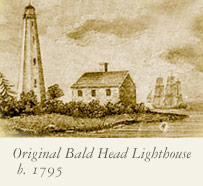Since the late 1700s, four lighthouses have warned mariners of the dangerous Frying Pan Shoals, while simultaneously guiding ships to the entrance of the Cape Fear River leading to the Port of Wilmington.
The first three lighthouses were built on Smith Island (now Bald Head). In 1795, the initial lighthouse (Bald Head Light) was constructed on the island’s southwest point and was quickly threatened by erosion. It was pulled down in 1813.
 In 1817, a new lighthouse, “Old Baldy,” was constructed for $15,915.45 on a ten-acre site. Still the oldest standing lighthouse in North Carolina, the octagonal brick and plaster tower stands 110 feet tall. Over the years an array of lamps and reflectors were used as a signal, including a “fourth-order” Fresnel lens. Old Baldy suffered from three conditions: too short, too dim, and too far inland. It was deactivated in 1903 upon completion of the Cape Fear Lighthouse. While no longer an active lighthouse, Old Baldy is open for visitors to enjoy and climb to the top.
In 1817, a new lighthouse, “Old Baldy,” was constructed for $15,915.45 on a ten-acre site. Still the oldest standing lighthouse in North Carolina, the octagonal brick and plaster tower stands 110 feet tall. Over the years an array of lamps and reflectors were used as a signal, including a “fourth-order” Fresnel lens. Old Baldy suffered from three conditions: too short, too dim, and too far inland. It was deactivated in 1903 upon completion of the Cape Fear Lighthouse. While no longer an active lighthouse, Old Baldy is open for visitors to enjoy and climb to the top.
 In the early 1900s, it was determined a taller, brighter lighthouse was needed and in 1903 the Cape Fear Lighthouse became operational on the southeastern end of Bald Head. Costing $70,000, the wrought-iron-and-steel open frame tower stood 161 feet tall, and utilized a first-order Fresnel lens. The light was incandescent oil vapor, using a six-inch wide mantle generating 160,000 candle power that was visible for 19 miles. The structure was demolished in 1958 so as not to cause confusion with the Oak Island Lighthouse.
In the early 1900s, it was determined a taller, brighter lighthouse was needed and in 1903 the Cape Fear Lighthouse became operational on the southeastern end of Bald Head. Costing $70,000, the wrought-iron-and-steel open frame tower stood 161 feet tall, and utilized a first-order Fresnel lens. The light was incandescent oil vapor, using a six-inch wide mantle generating 160,000 candle power that was visible for 19 miles. The structure was demolished in 1958 so as not to cause confusion with the Oak Island Lighthouse.
 By the mid-1950s, the Coast Guard and Corps of Engineers began to automate lighthouses, thus doing away with need for keepers, flammable fuels, hand-cranked weights to help rotate lens, and constant wick-trimming. Because Bald Head Island did not have electrical power until 1978, the new Oak Island (OKI) Lighthouse was constructed in 1958 adjacent to the existing Caswell Beach Coast Guard Station. The structure – costing $110,000 – is 153 feet tall, and the light can be seen for 16 nautical miles. Built of steel reinforced concrete with three rings of embedded color, there is no spiral staircase as found in other lighthouses. Rather, a total of 131 steps (ships’ ladders) leads up to the gallery (observation) level just below the lantern house. For the first five years, the lighthouse used carbon-arc mercury lamps housed in four 36-inch reflectors, generating 70 million candle power, making the lights the brightest in the US and second brightest in the world. Currently, the lights are powered by four 1,000 watt halogen bulbs – each placed in a separate 24-inch reflector – that produce 2.5 million candle power, displaying four one-second “flashes” followed by six seconds of “blank.” In 2004, the lighthouse and surrounding property were deeded to the Town of Caswell Beach as part of the Federal Lands to Parks program.
By the mid-1950s, the Coast Guard and Corps of Engineers began to automate lighthouses, thus doing away with need for keepers, flammable fuels, hand-cranked weights to help rotate lens, and constant wick-trimming. Because Bald Head Island did not have electrical power until 1978, the new Oak Island (OKI) Lighthouse was constructed in 1958 adjacent to the existing Caswell Beach Coast Guard Station. The structure – costing $110,000 – is 153 feet tall, and the light can be seen for 16 nautical miles. Built of steel reinforced concrete with three rings of embedded color, there is no spiral staircase as found in other lighthouses. Rather, a total of 131 steps (ships’ ladders) leads up to the gallery (observation) level just below the lantern house. For the first five years, the lighthouse used carbon-arc mercury lamps housed in four 36-inch reflectors, generating 70 million candle power, making the lights the brightest in the US and second brightest in the world. Currently, the lights are powered by four 1,000 watt halogen bulbs – each placed in a separate 24-inch reflector – that produce 2.5 million candle power, displaying four one-second “flashes” followed by six seconds of “blank.” In 2004, the lighthouse and surrounding property were deeded to the Town of Caswell Beach as part of the Federal Lands to Parks program.